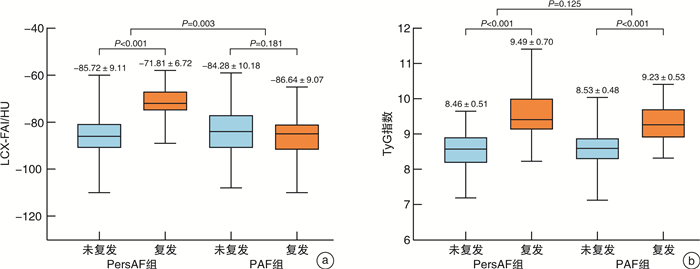The predictive value of pericoronary adipose tissue and TyG index on recurrence after radiofrequency ablation in patients with different types of atrial fibrillation
-
摘要: 目的 探究冠周脂肪(PCAT)及甘油三酯-葡萄糖(TyG)指数对不同类型心房颤动(房颤)患者射频消融术(RFCA)后复发的影响。方法 回顾性分析2018年8月—2022年12月首次且成功行RFCA的360例患者,分为持续性房颤(PersAF)组153例,及阵发性房颤(PAF)组207例,定期随访复发情况,根据术前冠状动脉CT血管成像(CCTA)测量PCAT相关参数,采集患者术前一般资料并计算TyG指数,比较两组患者临床及影像资料与复发情况。Cox回归分析复发的影响因素,受试者工作特征(ROC)曲线计算诊断效能。结果 中位随访11.5个月后,87例患者复发,其中PersAF组47例,PAF组40例。多因素Cox回归分析显示,左回旋支脂肪衰减指数(LCX-FAI)为PersAF患者复发的独立危险因素(P < 0.001);TyG指数为PersAF及PAF患者术后复发的独立危险因素(P < 0.001)。LCX-FAI、TyG指数预测PersAF患者术后复发曲线下面积(AUC)分别为0.898、0.892,二者联合AUC为0.951。TyG指数预测PAF患者术后复发的AUC为0.842。结论 TyG指数是PAF患者术后复发的独立危险因素,LCX-FAI和TyG指数可预测PersAF患者术后复发,二者联合预测价值更高。
-
关键词:
- 冠周脂肪 /
- 脂肪衰减指数 /
- 甘油三酯-葡萄糖指数 /
- 心房颤动 /
- 射频消融术
Abstract: Objective To investigate the effects of pericoronary fat(PCAT) and triglyceride glucose(TyG) index on recurrence after radiofrequency ablation(RFCA) in patients with different types of atrial fibrillation(AF).Methods A retrospective analysis was performed in 360 patients who underwent RFCA for the first time from August 2018 to December 2022. They were divided into 153 patients in the persistent atrial fibrillation(PersAF) group and 207 patients in the paroxysmal atrial fibrillation(PAF) group. The recurrence situation was regularly followed up, and PCAT related parameters were measured according to preoperative coronary CT angiography(CCTA). Preoperative general data of patients were collected and TyG index was calculated. Cox regression analysis was performed to analyze the influence factors of recurrence, and receiver operating characteristic(ROC) was used to calculate the diagnostic efficiency.Results After a median follow-up of 11.5 months, 87 patients recurred, including 47 patients in the PersAF group and 40 patients in the PAF group. Multivariate Cox regression analysis showed that LCX-FAI was an independent risk factor for recurrence in PersAF patients(P < 0.001). TyG index was an independent risk factor for postoperative recurrence in PersAF and PAF patients(P < 0.001). AUC of LCX-FAI and TyG index in PersAF patients were 0.898 and 0.892, respectively, and the combined AUC was 0.951. AUC of TyG index in PAF patients was 0.842.Conclusion TyG index is an independent risk factor for postoperative recurrence in patients with PAF. LCX-FAI and TyG index can effectively predict postoperative recurrence in patients with PersAF. -

-
表 1 PersAF组和PAF组临床资料及PCAT参数比较
Table 1. Comparison of clinical data and PCAT parameters
例(%), X±S, M(P25, P75) 项目 PersAF组(153例) PAF组(207例) χ2/Z/t P 男 103(67.32) 114(55.07) 5.512 0.019 年龄/岁 59.31±9.74 61.79±9.92 2.363 0.019 BMI/(kg/m2) 25.51(23.83,27.10) 24.62(23.44,26.54) -1.849 0.064 高血压 66(43.14) 93(44.93) 0.114 0.735 吸烟史 46(30.07) 36(17.39) 8.034 0.005 糖尿病 8(9.20) 34(12.45) 0.080 0.410 总胆固醇/(mmol/L) 4.16±1.07 4.32±0.93 1.526 0.128 甘油三酯/(mmol/L) 1.32(0.98,1.89) 1.37(1.08,1.84) -0.164 0.870 TyG指数 8.77±0.74 8.66±0.56 -1.537 0.125 高密度脂蛋白/(mmol/L) 1.07±0.27 1.09±0.29 0.625 0.532 低密度脂蛋白/(mmol/L) 2.38(1.96,2.92) 2.61(1.98,3.21) -1.737 0.082 CHA2DS2-VASc评分/分 2(1,3) 2(1,3) -0.972 0.331 LAD-V/cm3 1.31(1.08,1.54) 1.29(1.02,1.54) -0.122 0.903 LAD-FAI/HU -79(-86,-75) -79(-86,-74) -0.624 0.532 LCX-V/cm3 1.36(1.15,1.68) 1.37(1.13,1.68) -0.017 0.987 LCX-FAI/HU -81.44±10.60 -84.74±10.00 -3.010 0.003 RCA-V/cm3 1.49(1.23,1.78) 1.49(1.25,1.76) -0.152 0.879 RCA-FAI/HU -83.92±10.95 -83.72±10.81 0.164 0.870 CHA2DS2-VASc评分:非瓣膜性房颤脑卒中危险因素评分;LAD-V:左前降支周围脂肪组织体积;FAI:脂肪衰减指数;LCX-V:左回旋支周围脂肪组织体积;RCA-V:右冠脉周围脂肪组织体积。 表 2 PersAF与PAF患者RFCA后复发的多因素Cox回归分析
Table 2. Multivariate Cox regression analysis of the recurrence in patients with PersAF and PAF
项目 B SE Z HR 95%CI P VIF PersAF LCX-FAI 0.085 0.020 4.355 1.089 1.048~1.132 < 0.001 1.266 TyG指数 0.830 0.215 3.859 2.293 1.504~3.496 < 0.001 1.266 PAF 甘油三酯 0.153 0.145 1.052 1.165 0.877~1.548 0.293 TyG指数 1.634 0.255 6.402 5.123 3.107~8.448 < 0.001 表 3 PersAF与PAF患者术后复发危险因素的ROC曲线分析
Table 3. ROC curve analysis of risk factors for postoperative recurrence
项目 最佳阈值 灵敏度/% 特异度/% AUC(95%CI) PersAF LCX-FAI -75.5 HU 78.7 88.7 0.898(0.845~0.950) TyG指数 9 83.0 68.8 0.892(0.836~0.949) 二者联合 89.4 92.5 0.951(0.916~0.986) PAF TyG指数 8.815 80.0 75.4 0.842(0.779~0.906) -
[1] Arbelo E, Dagres N. The 2020 ESC atrial fibrillation guidelines for atrial fibrillation catheter ablation, CABANA, and EAST[J]. Europace, 2022, 24(Suppl 2): ii3-ii7.
[2] Calkins H, Hindricks G, Cappato R, et al. 2017 HRS/EHRA/ECAS/APHRS/SOLAECE expert consensus statement on catheter and surgical ablation of atrial fibrillation[J]. Heart Rhythm, 2017, 14(10): e275-e444. doi: 10.1016/j.hrthm.2017.05.012
[3] Hu Y F, Chen Y J, Lin Y J, et al. Inflammation and the pathogenesis of atrial fibrillation[J]. Nat Rev Cardiol, 2015, 12(4): 230-243. doi: 10.1038/nrcardio.2015.2
[4] 刘晓滢, 江杰, 段慧, 等. 冠状动脉周围脂肪CT衰减指数及影像组学的研究进展[J]. 实用放射学杂志, 2023, 39(9): 1541-1544.
[5] 王弘宇, 王腾玉, 田野. 血管周围脂肪组织在冠状动脉粥样硬化中的作用及评价指标[J]. 中华心血管病杂志, 2021, 43(9): 930-934.
[6] Wei Z, Zhu E, Ren C, et al. Triglyceride-glucose index independently predicts new-onset atrial fibrillation after septal myectomy for hypertrophic obstructive cardiomyopathy beyond the traditional risk factors[J]. Front Cardiovasc Med, 2021, 11: 8692511.
[7] 赵丽敏, 辛权达, 赵兴胜. 三酰甘油葡萄糖指数与心血管疾病相关性研究现状[J]. 国际心血管病杂志, 2023, 50(6): 358-361. https://www.cnki.com.cn/Article/CJFDTOTAL-GWXX202306006.htm
[8] Kehl KL, Zahrieh D, Yang P, et al. Rates of guideline-concordant surgery and adjuvant chemotherapy among patients with early-stage lung cancer in the US ALCHEMIST Study(Alliance A151216)[J]. JAMA Oncol, 2022, 8(5): 717-728. doi: 10.1001/jamaoncol.2022.0039
[9] 李雪博, 舒尚志, 李小宁, 等. 心外膜脂肪组织体积与心房颤动的相关性研究[J]. 临床心血管病杂志, 2019, 35(12): 1104-1109. doi: 10.13201/j.issn.1001-1439.2019.12.010
[10] Fitzgibbons TP, Czech MP. Epicardial and perivascular adipose tissues and their influence on cardiovascular disease: basic mechanisms and clinical associations[J]. J Am Heart Assoc, 2014, 3(2): e000582. doi: 10.1161/JAHA.113.000582
[11] Ormazabal V, Nair S, Elfeky O, et al. Association between insulin resistance and the development of cardiovascular disease[J]. Cardiovasc Diabetol, 2018, 17(1): 1-14. doi: 10.1186/s12933-017-0656-x
[12] 孙梓宜, 王子涵, 陈颖, 等. TyG指数联合血管功能指标对冠状动脉狭窄程度的预测价值[J]. 临床心血管病杂志, 2022, 38(1): 17-21. doi: 10.13201/j.issn.1001-1439.2022.01.004
[13] Nogami K, Sugiyama T, Kanaji Y, et al. Association between pericoronary adipose tissue attenuation and outcome after second-generation cryoballoon ablation for atrial fibrillation[J]. Br J Radiol, 2021, 11: 9420210361.
[14] Ciuffo L, Nguyen H, Marques MD, et al. Periatrial fat quality predicts atrial fibrillation ablation outcome[J]. Circ Cardiovasc Imaging, 2019, 12(6): e008764. doi: 10.1161/CIRCIMAGING.118.008764
[15] 王喆, 江耀辉, 张悦坤, 等. 计算机断层摄影术心脏成像评价不同类型心房颤动患者左心房内形态结构的临床研究[J]. 临床心血管病杂志, 2020, 36(12): 1130-1134. doi: 10.13201/j.issn.1001-1439.2020.12.013
[16] Ma GJ, Guo FQ, Hu J, et al. Association of pericoronary adipose tissue with atrial fibrillation recurrence after ablation based on computed tomographic angiography[J]. Jpn J Radiol, 2023, 41(9): 955-964. doi: 10.1007/s11604-023-01426-x
[17] Bohne LJ, Johnson D, Rose RA, et al. The association between diabetes mellitus and atrial fibrillation: clinical and mechanistic insights[J]. Front Physiol, 2019, 10: 135. doi: 10.3389/fphys.2019.00135
[18] Chan YH, Chang GJ, Lai YJ, et al. Atrial fibrillation and its arrhythmogenesis associated with insulin resistance[J]. Cardiovasc Diabetol, 2019, 18(1): 125. doi: 10.1186/s12933-019-0928-8
[19] Tang Q, Guo XG, Sun Q, et al. The pre-ablation triglyceride-glucose index predicts late recurrence of atrial fibrillation after radiofrequency ablation in non-diabetic adults[J]. BMC Cardiovasc Disord, 2022, 22(1): 219-230. doi: 10.1186/s12872-022-02657-y
-





 下载:
下载:



